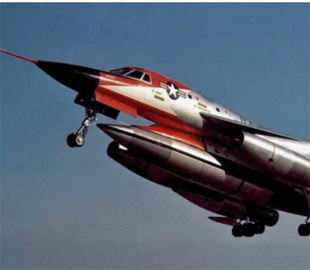
The B-58 was the world's first supersonic bomber to reach Mach 2. In its time, it set 19 world speed and altitude records, winning 5 aviation trophies.
Despite the impressive performance of this aircraft, any serious failure was fatal to it due to its high speeds. Eight B-58s survive, including the Cowtown Hustler, which is on display at the National Museum of the United States Air Force.
Focus translated an article by journalist Peter Suchiu about the supersonic bomber that was in service with the US Air Force in the 1960s.
The Convair B-58 Hustler was the world's first supersonic bomber to reach Mach 2. Developed in the 1950s for the US Air Force's Strategic Air Command during the Cold War, it evaded enemy air defenses thanks to its speed and altitude. The aircraft had a revolutionary tailless delta wing design and was built of heat-resistant stainless steel using a “honeycomb sandwich” principle.
- Its thin fuselage could not accommodate bombs, so it carried a unique two-piece pod under the fuselage for nuclear weapons and additional fuel. Between 1960 and 1970, the B-58 set 19 world speed and altitude records and won 5 aviation trophies.
- The crew of three sat in tandem pressurized cockpits and communicated via notes transmitted via a pulley system.
Despite the aircraft's impressive performance, any serious failure was fatal due to its high speeds. Eight B-58s survive, including the Cowtown Hustler, which is on display at the National Museum of the United States Air Force.
B-58 Hustler: The World's First Mach 2 Supersonic Bomber
The Convair B-58 Hustler, a three-seat aircraft, was the first supersonic bomber to reach Mach 2. Designed for high-altitude flight, it was the first aircraft to be constructed primarily of heat-resistant stainless steel in a honeycomb sandwich design, with a thin fuselage and a thick payload pod. The thin fuselage made it impossible to carry bombs inside the fuselage, so a two-piece pod was installed under the fuselage for them.
A product of the Cold War, the aircraft carried nuclear weapons in this pod to strike targets in the Soviet Union and other Soviet allies, as well as additional fuel and even advanced reconnaissance equipment.
After dropping the payload — bombs and an empty fuel tank — the bomber became much smaller.
B-58 Hustler: Speed Demon
Developed in the 1950s for the Air Force's Strategic Air Command (SAC), the Hustler's defense was based on its speed. At that time, it was believed that if the plane flew fast enough or at least high enough, then the enemy would not be able to shoot it down. Despite the enormous technical difficulties, the B-58 was developed with amazing speed and success.
For its time, the B-58 Hustler was revolutionary in many ways. It featured the latest tailless delta wing design, but at the same time had a complex inertial navigation and bombardment system, as well as a thin “wasp-waisted” fuselage.
The aerodynamic design of the Convair B-58 allowed the first production model to fly for over an hour at a supersonic speed of over Mach 2.
Despite having to refuel once, the bomber was able to cover the distance of 2,703 km in just 80 minutes.
During its service with the Strategic Command from 1960 to 1970, the B-85 set 19 world speed and altitude records, and the aircraft itself won five different aviation trophies.
Unique configuration
The uniqueness of the B-58 Hustler also lay in the configuration of the crew. The pilot, navigator, and protection systems operator sat in tandem in pressurized cockpits, each of which could eject in the event of an accident. The cabins were even separated by equipment bays.
The crew had no physical contact with each other, but Air & Space Magazine reported that the crew usually passed notes via a pulley system that ran along the cabin wall.
The speed of the aircraft left no chance for enemy fighters to catch up with the B-58, but at the same time, almost any failure of the airframe or any system was fatal for the crew.
Initially, the aircraft was equipped only with standard ejection seats, which could not be used safely at Mach 2. Later, the bomber was retrofitted with a pressurized ejection system.
Convair built 116 B-58s, including 30 test and pre-production models, as well as 86 examples that entered service. The Hustler flew with the Strategic Air Command from 1960 to 1970. Eight B-58s survive today, including the Cowtown Hustler, which set three speed records during a flight from Los Angeles to New York and back on March 5, 1962. For this flight, the crew received the Bendix and McKay trophies for 1962.
Since December 1969, the aircraft has been in the collection of the National Museum of the United States Air Force.
About the author
Peter Suchiu — is a journalist from Michigan. During his twenty-year journalistic career, he participated in the work of more than four dozen magazines, newspapers and websites, publishing more than 3,200 materials. He writes regularly about military technology, firearms history, cybersecurity, politics, and international affairs. Peter has also contributed to Forbes and Clearance Jobs. You can follow him on Twitter: @PeterSuciu. Email the author at Editor@nationalinterest.org.

